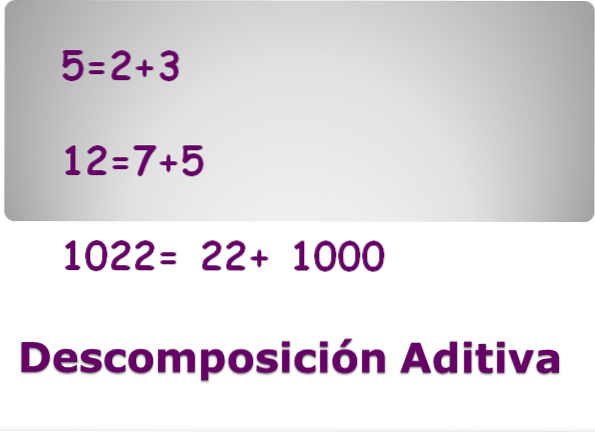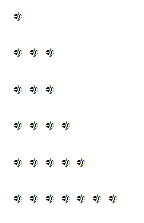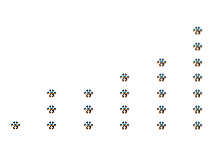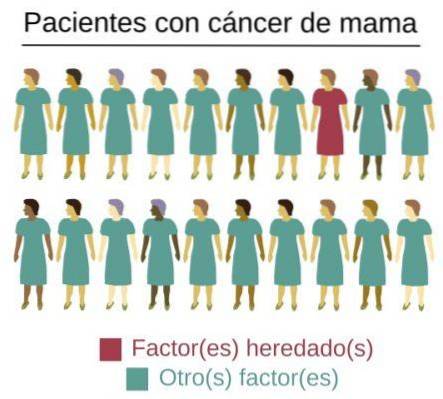
Additive decomposition applications, partitions, graphics

The additive decomposition of a positive integer is to express it as a sum of two or more positive integers. Thus, we have that the number 5 can be expressed as 5 = 1 + 4, 5 = 2 + 3 or 5 = 1 + 2 + 2. Each of these ways of writing the number 5 is what we will call additive decomposition.
If we pay attention we can see that the expressions 5 = 2 + 3 and 5 = 3 + 2 represent the same composition; they both have the same numbers. However, just for a matter of convenience, each of the addends is usually written following the criterion from lowest to highest.

Article index
- 1 Additive decomposition
- 2 Canonical additive decomposition
- 3 Applications
- 3.1 Example theorem
- 4 Partitions
- 4.1 Definition
- 5 Charts
- 6 References
Additive decomposition
As another example we can take the number 27, which we can express as:
27 = 7 + 10 + 10
27 = 9 + 9 + 9
27 = 3 + 6 + 9 + 9
27 = 9 + 18
Additive decomposition is a very useful tool that allows us to reinforce our knowledge of numbering systems.
Canonical additive decomposition
When we have numbers with more than two digits, a particular way to decompose them is in the multiples of 10, 100, 1000, 10 000, etc., that make it up. This way of writing any number is called canonical additive decomposition. For example, the number 1456 can be decomposed as follows:
1456 = 1000 + 400+ 50 + 6
If we have the number 20 846 295, its canonical additive decomposition will be:
20 846 295 = 20,000,000 + 800,000 + 40,000 + 6000 + 200 + 90 +5.
Thanks to this decomposition, we can see that the value of a given digit is given by the position it occupies. Let's take the numbers 24 and 42 as an example:
24 = 20 + 4
42 = 40 +2
Here we can see that in 24 the 2 has a value of 20 units and the 4 a value of 4 units; on the other hand, in 42 the 4 has a value of 40 units and the 2 of two units. Thus, although both numbers use the same digits, their values are totally different due to the position they occupy.
Applications
One of the applications that we can give to additive decomposition is in certain types of proofs, in which it is very useful to see a positive integer as the sum of others.
Example theorem
Let us take as an example the following theorem with its respective proofs.
- Let Z be a 4-digit integer, then Z is divisible by 5 if its units figure is zero or five.
Demonstration
Let's remember what divisibility is. If we have “a” and “b” integers, we say that “a” divides “b” if there is an integer “c” such that b = a * c.
One of the properties of divisibility tells us that if “a” and “b” are divisible by “c”, then the subtraction “a-b” is also divisible..
Let Z be a 4-digit integer; therefore we can write Z as Z = ABCD.
Using canonical additive decomposition we have:
Z = A * 1000 + B * 100 + C * 10 + D
It is clear that A * 1000 + B * 100 + C * 10 is divisible by 5. For this reason we have that Z is divisible by 5 if Z - (A * 1000 + B * 100 + C * 10) is divisible by 5.
But Z - (A * 1000 + B * 100 + C * 10) = D and D is a single digit number, so the only way for it to be divisible by 5 is for it to be 0 or 5.
Therefore, Z is divisible by 5 if D = 0 or D = 5.
Note that if Z has n digits the proof is exactly the same, it only changes that now we would write Z = A1TOtwo… TOn and the objective would be to prove that An it's zero or five.
Partitions
We say that a partition of a positive integer is a way in which we can write a number as a sum of positive integers.
The difference between an additive decomposition and a partition is that, while the first one seeks that at least it can be decomposed into two addends or more, the partition does not have this restriction.
Thus, we have the following:
5 = 5
5 = 1 + 4
5 = 2 + 3
5 = 1 + 2 + 2
The above are partitions of 5.
That is, we have that every additive decomposition is a partition, but not every partition is necessarily an additive decomposition..
In number theory, the fundamental theorem of arithmetic guarantees that every integer can be uniquely written as a product of primes.
When studying partitions, the goal is to determine in how many ways a positive integer can be written as the sum of other integers. Therefore we define the partition function as presented below.
Definition
The partition function p (n) is defined as the number of ways that a positive integer n can be written as a sum of positive integers.
Returning to the example of 5, we have that:
5 = 5
5 = 1 + 4
5 = 2 + 3
5 = 1 + 1 + 3
5 = 1 + 2 + 2
5 = 1 + 1 + 1 + 2
5 = 1 + 1 + 1 + 1 + 1
Thus, p (5) = 7.
Graphics
Both partitions and additive decompositions of a number n can be represented geometrically. Suppose we have an additive decomposition of n. In this decomposition the addends can be arranged so that the members of the sum are ordered from least to greatest. So, okay:
n = a1 + totwo + to3 +… + Ar with
to1 ≤ atwo ≤ a3 ≤… ≤ ar.
We can graph this decomposition in the following way: in a first row we mark the a1-points, then in the next we marktwo-points, and so on until reaching ar.
Take for example the number 23 and its following decomposition:
23 = 5 + 4 + 7 + 3 + 1 +3
We order this decomposition and we have:
23 = 1 + 3 + 3 + 4+ 5 + 7
Its corresponding graph would be:

Likewise, if we read said graph vertically instead of horizontally, we can obtain a decomposition that is possibly different from the previous one. In the example of 23, the following stands out:

So we have 23 we can also write it as:
23 = 6 + 5 + 5 + 3 + 2 + 1 + 1.
References
- G.H. Hardy and E. M. Wright. An Introducction to Theory of Numbers. Oxford Clarendon Press.
- Navarro C. Didactic Encyclopedia 6. Editorial Santillana, S.A.
- Navarro C.Link to Math 6. Editorial Santillana, S.A.
- Niven & Zuckerman. Introduction to number theory. Limusa.
- VV.AA Evaluation Criterion of the area of mathematics: A model for primary education. Wolters Kluwer Education.
- Didactic Encyclopedia 6.



Yet No Comments